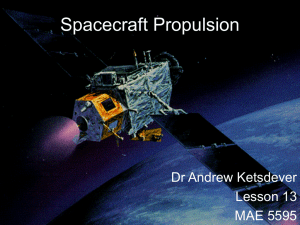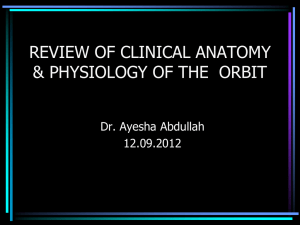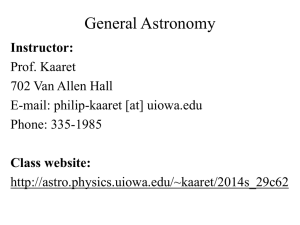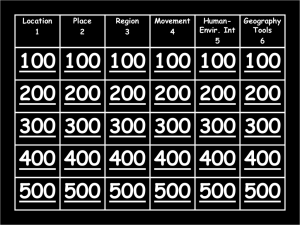OrbMech_2013
advertisement
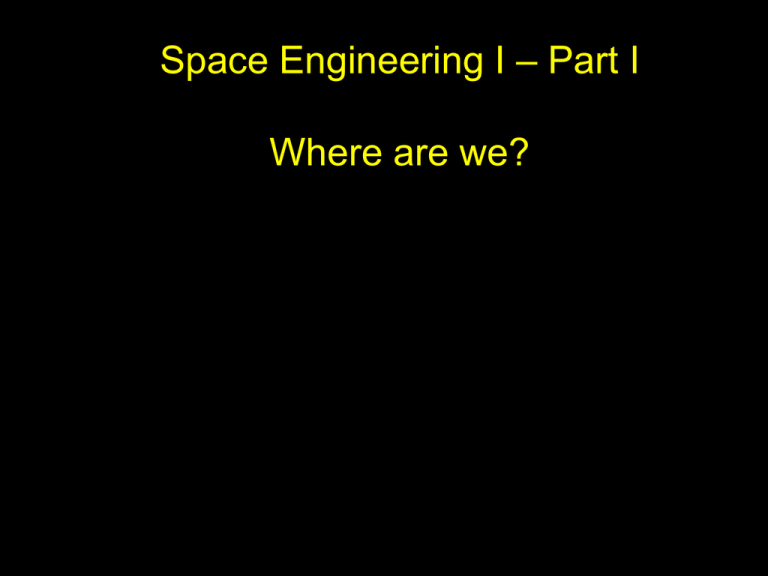
Space Engineering I – Part I Where are we? Where are we? Where we going? Where are we relative to what? Johannes Kepler 1571-1630 Issac Newton 1642-1727 Newton's laws of motion and universal gravitation dominated scientists' view of the physical universe for the next three centuries. Newton derived Kepler’s laws of planetary motion from his mathematical description of gravity, removing the last doubts about the validity of the heliocentric model of the cosmos. Coordinate Systems (X,Y,Z) (R,q,l) (R,j,l) Origin? Center of Earth Sun or a Star Center of a planetary body Others…. Reference Axes Axis of rotation or revolution Earth spin axis • Equatorial Plane Plane of the Earth’s orbit around the Sun • Ecliptic Plane Need to pick two axes and then 3rd one is determined Ecliptic and Equatorial Planes Obliquity of the Ecliptic = 23.44 ° Vernal Equinox vector - Earth to Sun on March 21st - Planes intersect @ Equinox Inertial Coordinates Relationship between Coordinate Frames Orbital Elements a - semi-major axis Ω - right ascension of ascending node e - eccentricity - argument of perigee i - inclination - true anomaly Properties of Orbits • a is the semimajor axis; • b is the semiminor axis; • rMAX = ra, rMIN = rp are the maximum and minimum radius-vectors; • c is the distance between the focus and the center of the ellipse; • e = c/a is eccentricity b a 2 = 1 - e2 • 2p is the latus rectum (latus = side and rectum = straight) p — semilatus rectum or semiparameter • A = ab is the area of the ellipse p = 1 + e cos q r Why do we need all this? Launch into desired orbit Launch window, inclination Ground coverage (ground track/swath) LEO/GEO Purpose of mission? Orbital Manoeuvers Feasible trajectories Minimize propulsion required Station keeping Tracking, Prediction Interplanetary Transfers Hyperbolic orbits Changing reference frames Orbital insertion Rendezvous/Proximity Operations Relative motion Orbital dynamics Bird’s Eye View A 3D Situational Awareness Tool for the Space Station Review of Orbital Elements e 120° 150° 90° Eccentricity (0.0 to 1.0) Apogee 180° v True anomaly (angle) a Semi-major Perigee 0° axis e=0.8 vs e=0.0 e a v defines ellipse shape defines ellipse size defines satellite angle from perigee Inclination i Intersection of the equatorial and orbital planes Inclination (above) (angle) i (below) Ascending Node Equatorial Plane ( defined by Earth’s equator ) Ascending Node is where a satellite crosses the equatorial plane moving south to north Right Ascension of the ascending node Ω and Argument of perigee ω Ω = angle from vernal equinox to ascending node on the equatorial plane Perigee Direction ω = angle from ascending node to perigee on the orbital plane ω Ω Ascending Node Vernal Equinox The Six Orbital Elements a = Semi-major axis (usually in kilometers or nautical miles) e = Eccentricity (of the elliptical orbit) v = True anomaly The angle between perigee and satellite in the orbital plane at a specific time i = Inclination The angle between the orbital and equatorial planes Ω = Right Ascension (longitude) of the ascending node The angle from the Vernal Equinox vector to the ascending node on the equatorial plane = Argument of perigee The angle measured between the ascending node and perigee Shape, Size, Orientation, and Satellite Location. Computing Orbital Position Mean Anomaly Eccentric Anomaly True Anomaly Mean Motion Two Line Orbital Elements N ASA and NORAD Standard for specifying orbits of Earth-orbiting satellites ISS (ZARYA) 1 25544U 98067A 08264.51782528 −.00002182 00000-0 -11606-4 0 2927 2 25544 51.6416 247.4627 0006703 130.5360 325.0288 15.72125391563537 Ref: http://en.wikipedia.org/wiki/Two-line_element_set Equations of Motion Equations of Motion (2) Equations of Motion (3) Conservation of Energy For a circular orbit, balancing the force of gravity and the centripetal acceleration Since or Equations of Motion (4) An orbit is a continually changing balance between potential and kinetic energy Potential Energy Kinetic Energy Using For any Kepler orbit (elliptic, parabolic, hyperbolic or radial), this is the Vis Viva equation Orbital Period vs. Altitude a3 P = 2 m h = 160 n.mi P = 90 minutes “High” Earth Orbit H = 3444 n.mi P = 4 hours Geosynchronous Orbit h = 19,324 n.mi P = 23 h 56 m 4 s Orbital Velocity vs. Altitude h = 160n.mi V = 25,300 ft/s “High” Earth Orbit H = 3444 n.mi V = 18,341 ft/s Geosynchronous Orbit h = 19,324 n.mi V = 10,087 ft/s Orbital Velocity vs. Altitude (Elliptical Orbits) h = 19,324 n.mi V = 5,273 ft/s h = 160 n.mi V = 33,320 ft/s Geosynchronous Transfer Orbit a = 13,186 n.mi e = 0.726 Possible Orbital Trajectories • e=0 -- circle • e<1 -- ellipse • e=1 -- parabola • e>1 -- hyperbola e < 1 Orbit is ‘closed’ – recurring path (elliptical) e > 1 Not an orbit – passing trajectory (hyperbolic) Parabolic Trajectories Total Energy = 0 Hyperbolic Trajectories Total Energy > 0 As State Vectors Cartesian x, y, z, and 3D velocity Integrating Multi-Body Dynamics Solar and Sidereal Time The Sun Drifts east in the sky ~1° per day. Rises 0.066 hours later each day. (because the earth is orbiting) The Earth… Rotates 360° in 23.934 hours (Celestial or “Sidereal” Day) Rotates ~361° in 24.000 hours (Noon to Noon or “Solar” Day) Satellites orbits are aligned to the Sidereal day – not the solar day Ground Track Ground tracks drift westward as the Earth rotates below. 360 deg / 24 hrs = 15 deg/hr Perturbations - J2000 Inertial Frame Orbit Perturbations - Atmospheric Drag Atmospheric density is a function of latitude, solar heating, season, land masses, etc. Drag also depends on spacecraft attitude Effect is to lower the apogee of an elliptical orbit Perigee remains relatively constant Orbit Perturbations - Gravitational Potential Spherical Term Zonal Harmonics where m = Universal Gravitational Constant X Mass of Earth r = Spacecraft Radius Vector from Center of Earth ae = Earth Equatorial Radius P() = Legendre Polynomial Functions f = Spacecraft Latitude l = Spacecraft Longitude Jn = Zonal Harmonic Constants Cn,m,Sn,m = Tesseral & Sectorial Harmonic Coefficients Only the first 4X4 (n=4, m=4) elements are used in Space Shuttle software. J2 has 1/1000th the effect of the spherical term; Tesseral Harmonics Sectorial Harmonics all other terms start at 1/1000th of J2’s effect. , d Orbit Perturbations - “The J2 Effect” f t The Earth’s oblateness causes the most significant perturbation of any of the nonspherical terms. i h orbit J2 l S h Right Ascension of the Ascending Node, Argument of Perigee and Time since Perigee Passage are affected. -1 0 100 -9 a 200 -7 -6.7 300 500 Typical Shuttle Orbits -6 o Nodal Regression is the most important operationally. Magnitude depends on orbit size (a), shape (e) and inclination (i). d -8 -5 1000 -4 -3 Posigrade orbits’ nodes regress Westward (0° < i < 90°) Retrograde orbits’ nodes regress Eastward (90° < i <180°) N h -2 -1 0 10 20 30 0 3940 50 60 70 80 90 180 170 160 150 140 130 120 110 100 Inclination, Degrees Nodal Regression Orbital planes rotate eastward over time. (above) Ascending Node (below) Nodal Regression can be used to advantage (such as assuring desired lighting conditions) Coverage from GEO TDRSS Comm Coverage Geosynchronous Orbit Sun-Synchronous Orbits Relies on nodal regression to shift the ascending node ~1° per day. Scans the same path under the same lighting conditions each day. The number of orbits per 24 hours must be an even integer (usually 15). Requires a slightly retrograde orbit (I = 97.56° for a 550km / 15-orbit SSO). Each subsequent pass is 24° farther west (if 15 orbits per day). Repeats the pattern on the 16th orbit Used for reconnaissance (or terrain mapping – with a bit of drift). Molniya - 12hr Period ‘Long loitering’ high latitude apogee. Once used used for early warning by both USA and USSR Changing Orbits - The Effects of Burns Posigrade & Retrograde Orbital Direction Initial O rbit h Final O rbit V V T y p i c a l S h u t t l e O r b i t s : 1 f t / s e c V y i e l d s1 / 2 n m i h A posi-grade burn will RAISE orbital altitude. A retro-grade burn will LOWER orbital altitude. Note – max effect is at 180° from the burn point. h Changing Orbits - The Effect of Burns Radial In & Radial Out V= m ( r2 1 a ) EXAMPLE: Radial In Burn at Perigee Orbital Direction Resultant Velocity Initial Velocity Radial burns shift the argument of perigee without significantly altering other orbital parameters Initial O rbit Final O rbit Orbital Transfers - Changing Planes V2 V V1 •Burn point must be intersection of two orbits (“nodal crossings”) •Extremely expensive energywise: For 160 nmi circular orbits, a 1° of plane change requires a V of over 470 ft/sec. Homann Transfer • Vc2 We want to move spacecraft from LEO → GEO GEO • Initial LEO orbit has radius r1 and velocity Vc1 V c1 = GM LEO r1 • Desired GEO orbit has radius r2 and velocity Vc2 • • At LEO (r1), Vc1 = 7,724 m/s At GEO (r2), Vc2 = 3,074 m/s • Could accomplish this in many ways r1 Vc1 r2 Homann Transfer • Vc2 We want to move spacecraft from LEO → GEO GEO • Initial LEO orbit has radius r1 and velocity Vc1 V c1 = GM LEO r • Desired GEO orbit has radius r2 and velocity Vc2 • • At LEO (r1), Vc1 = 7,724 m/s At GEO (r2), Vc2 = 3,074 m/s • Could accomplish this in many ways r1 Vc1 r2 Homann Transfer • Vc2 We want to move spacecraft from LEO → GEO GEO • Initial LEO orbit has radius r1 and velocity Vc1 V c1 = GM LEO r • Desired GEO orbit has radius r2 and velocity Vc2 • • At LEO (r1), Vc1 = 7,724 m/s At GEO (r2), Vc2 = 3,074 m/s • Could accomplish this in many ways r1 Vc1 r2 Homann Transfer • Vc2 We want to move spacecraft from LEO → GEO GEO • Initial LEO orbit has radius r1 and velocity Vc1 V c1 = GM LEO r • Desired GEO orbit has radius r2 and velocity Vc2 • • At LEO (r1), Vc1 = 7,724 m/s At GEO (r2), Vc2 = 3,074 m/s • Hohmann Transfer Orbit – Most Efficient Method r1 Vc1 r2 Homann Transfer Vc2 GEO • Impulsive V1 is applied to get on geostationary transfer orbit (GTO) at perigee: GTO LEO V1 = 2m r1 2m r1 r2 m r1 r1 m = GM r2 • Leave LEO (r1) with a total velocity of V1 V1 Vc1 V1 Homann Transfer Vc2 Apogee GEO • Impulsive V1 is applied to get on geostationary transfer orbit (GTO) at perigee: V1 = • 2m r1 2m r1 r2 GTO LEO m r1 r1 Leave LEO (r1) with a total velocity of V1 r2 • V1 Vc1 Transfer orbit is elliptical shape – Perigee located at r1 – Apogee located at r2 Perigee V1 Homann Transfer Vc2 V2 • Arrive at GEO (apogee) with V2 • When arriving at GEO, which is at apogee of elliptical transfer orbit, must apply some V2 in order to circularize: V2 = • • m r2 2m r2 V2 GEO GTO LEO r1 2m r1 r2 This is exactly the V that should be applied to circularize the orbit at GEO (r2) – Vc2 = V2 + V2 If this V is not applied, spacecraft will continue on dashed elliptical trajectory V1 Vc1 r2 V1 Homann Transfer • Initial LEO orbit has radius r1 and velocity Vc1 GM V c1 = • • V2 V2 GEO r Desired GEO orbit has radius r2 and velocity Vc2 Impulsive V1 is applied to get on geostationary transfer orbit (GTO) at perigee: V1 = • Vc2 2m r1 2m r1 r2 m r2 2m r2 LEO r1 m r1 Coast to apogee and apply impulsive V2: V2 = GTO 2m r1 r2 V1 Vc1 r2 V1 3. Second Hohmann burn circularizes at GEO Super GTO GEO Target Orbit Initial orbit has greater apogee than standard GTO. Plane change at much higher altitude requires far less ΔV. PRO: Less overall ΔV from higher inclination launch sites. CON: Takes longer to establish the final orbit. 2. Plane change plus initial Hohmann burn 1. Launch to ‘Super GTO’ Orbital Rendezvous (Shuttle with ISS) Interplanetary Trajectories (Patched Conic Approximation) Gravity Assist Farewell

